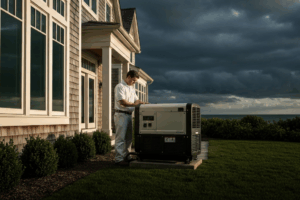What Is the NFPA 70?
Introduction
The NFPA 70 (National Electrical Code, NEC) is the cornerstone of electrical safety in the U.S., governing wiring and equipment installation. Widely adopted as law, it’s mandatory for electricians to ensure safe, compliant practice. This guide covers the NEC’s structure, applications, and safety impact.
Understanding the Structure of the NEC
The NFPA 70 comprises nine chapters:
- General: Rules and definitions (e.g., accessible; NEC Article 100).
- Wiring and Protection: Conductors, overcurrent protection, grounding (e.g., wire ampacity chart; NEC 310).
- Wiring Methods: Raceways, cables, conduits (NEC 300).
- Equipment for General Use: Receptacle outlets, lighting (NEC 406).
- Special Occupancies: Hazardous areas (NEC 500).
- Special Equipment: Signs, escalators (NEC 600).
- Special Conditions: Emergency systems, fiber optics (NEC 700).
- Communications Systems: Phone, data cables (NEC 800).
- Tables: Ampacity charts (NEC 310.16).
Updated every three years, the NEC reflects new technologies and safety standards.
Applying NFPA 70 for Safe Electrical Installations
The NFPA 70 ensures safe electrical installations by providing clear standards for wiring, components, and compliance. Electricians rely on it to prevent hazards and meet legal requirements.
The NEC in Practice
The NEC guides:
- Sizing/Loads: Use wire ampacity charts to prevent overheating (NEC 310.15).
- Components: Requires surge protective devices for certain service upgrades (NEC 230.67).
- Installation: Specifies cable tying to avoid damage (NEC 300.4).
- Receptacles: Mandates GFCI outlets in wet areas (NEC 210.8).
Non-compliance risks hazards, failed inspections, and liability.
Safety Protocols
NFPA 70E complements NEC for workplace safety:
- De-energize: Verify with voltage testers; use lock-out/tag-out (LOTO) (NFPA 70E 120.2).
- Arc Flash: Use PPE for live work (NFPA 70E 130.7).
- Continuous Learning: Stay updated with NEC/NFPA 70E revisions.
Conclusion
The NFPA 70 is a vital blueprint for safe, compliant electrical systems. From ampacity charts to receptacle requirements, it guides electricians to protect lives and property while meeting legal standards.
Take the next step in your professional growth! Visit Expert CE (https://expertce.com/) for all your continuing education needs.
Continuing Education by State
Select your state to view board-approved continuing education courses and requirements:
Disclaimer: The information provided in this educational content has been prepared with care to reflect current regulatory requirements for continuing education. However, licensing rules and regulations can vary by state and are subject to change. While we strive for accuracy, ExpertCE cannot guarantee that all details are complete or up to date at the time of reading. For the most current and authoritative information, always refer directly to your state’s official licensing board or regulatory agency.



